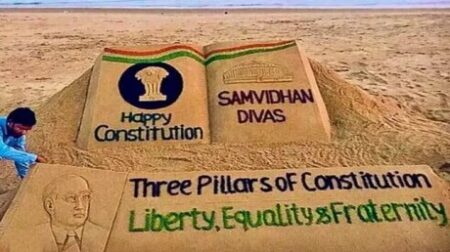This article is about the presidential election of India,2022. This article will include about the election, poll process of conducting poll, the game of numbers and probable candidates for the position.

The President of India does not have executive powers, but all executive decisions are made in his or her name. The president is bound by the Constitution to follow the advice of the Prime Minister’s council of ministers.
The President, on the other hand, has the authority to ask the government to review its policies and to offer advice. For instance, in matters of legislation. As a result, it would be incorrect to argue that the President’s duty is purely ceremonial or that he is merely a figurehead or rubber stamp.
Presidents like Pranab Mukherjee have been outspoken, particularly when it comes to mercy appeals from death row inmates. When no party wins a parliamentary majority in a national election, the President plays one of the most important tasks.
As a result, the presidential election is critical, and you should be concerned. Although the election is indirect, the outcome reveals how much public support both the administration and the opposition enjoy throughout the country.
Presidential election of 2022
On June 15, an announcement was issued for the election of India’s 16th President. On July 18, a poll will be held for the presidential election. On July 21, the votes will be counted if necessary, and the results will be announced. In the case of a consensus candidate, there will be no voting. The current President of India, Ram Nath Kovind, will leave office on July 24.
The process of conducting a poll: –
Members of the Electoral College, which includes elected members of both Houses of Parliament as well as elected members of the Legislative Assemblies of all states, the National Capital Territory of Delhi, and the Union Territory of Puducherry, vote for the president.
This means that nominated members of the Rajya Sabha and Lok Sabha, as well as members of state legislatures, are not included in the Electoral Vote. Members of Legislative Councils, likewise, do not take part in the election process.
The value of MPs’ and MLAs’ votes vary depending on the population of the states from which they are elected. It is required that 50 MPs suggest the nominee, with another 50 supporting the nomination.
Polling will take place in Parliament House and the State Legislative Assemblies’ buildings. The election is conducted using a secret ballot system. The proportional representation system uses a single transferable vote.
There are two columns on the ballot paper. In the first column, the names of the candidates are displayed, and in the second column, the order of choice is mentioned.
The game of numbers : –
There are 4,809 electors in the Election System, comprising 776 Members of Parliament and 4,033 Members of Legislative Assemblies (MLAs). There will be a total of 10,86,431 votes cast. A contender must receive at least 5,43,216 votes to win.
The NDA’s Ram Nath Kovind beat the joint Opposition candidate Meira Kumar in the 2017 election. Out of a total of 10,69,358 votes cast, Kovind received 7,02,000 votes to Kumar’s 3,67,000 votes.
This time around, the ruling BJP-led National Democratic Alliance (NDA) had almost 48% of the vote. The United Progressive Alliance, which is led by Congress, had 23% of the vote (UPA).
This is quite unlikely. According to certain reports, “independents” such as the ruling YSRCP in Andhra Pradesh and the ruling BJD in Odisha may support the NDA. The AIADMK, the BJP’s Tamil Nadu ally, might even do so.
The BJP’s party president, JP Nadda, and Union minister Rajnath Singh have been given permission to undertake discussions with members of the NDA and UPA, as well as other political parties and independents.
Probable candidates for the position: –
The BJP is widely believed to be unlikely to re-nominate Kovind. The only President to serve two full terms was Rajendra Prasad. Both camps have yet to announce their nominees. That isn’t to say we aren’t open to recommendations.
Some leaders have approached former West Bengal Governor and Mahatma Gandhi’s grandson, Gopalkrishna Gandhi, to run as an united Opposition candidate. He is the proposal of the Left.
There are rumors that NCP president Sharad Pawar is considering nominating dissident Congress leader Ghulam Nabi Azad as the Opposition’s candidate.
Kerala Governor Mohammad Arif Khan, former Jharkhand Governor and Odisha tribal leader Draupadi Murmu, Chhattisgarh Governor and tribal leader Anusuiya Uikey, Telangana Governor Tamilsai Soundararajan, Karnataka Governor and Dalit leader Thawar Chand Gehlot, former Lok Sabha Speaker Sumitra Mahajan, and Odisha tribal leader Jual Oram are among the NDA’s likely candidates.
The name of TMC leader Yashwant Sinha is also being mentioned, (though Bengal’s governing party TMC has stated that none of its own members will run).
According to sources, the Congress, TMC, AAP, and Shiv Sena all wanted Pawar to be the opposition’s candidate, but he turned down the offer.
Shravan Kumar, a JD(U) leader and Bihar minister, has suggested that party chairman and Bihar Chief Minister Nitish Kumar could be an excellent candidate. Nawab Malik, a Maharashtra minister and NCP spokesperson, said Kumar’s candidacy as an opposition candidate might be considered if he breaks links with the BJP/NDA in Bihar. Nitish Kumar, on his part, has stated that he has never desired to run for President and will not do so.
This is how exactly the presidential election happen, there is a whole process, which takes place as mentioned above and then there is a list which shows the probable candidates for the election. The 2022 presidential election is very crucial like all the presidential election which have taken place in the country, the person who becomes the president should take up all the responsibilities and run the country smoothly.













